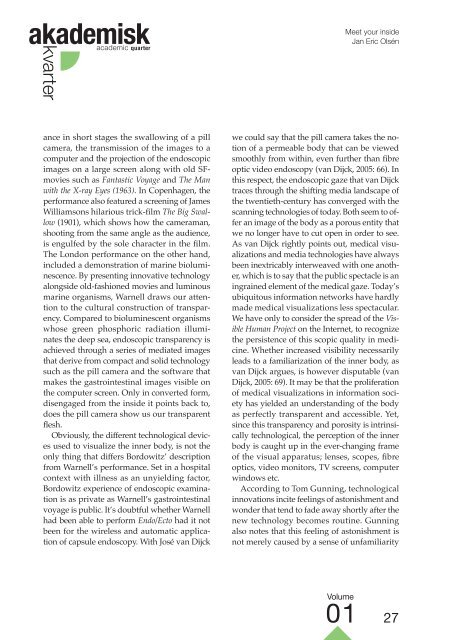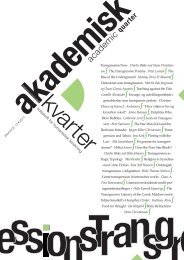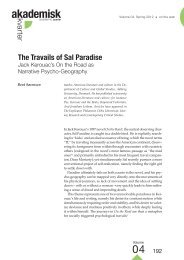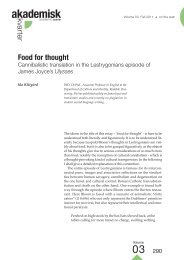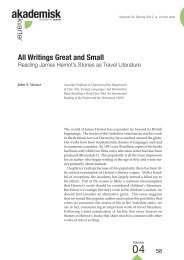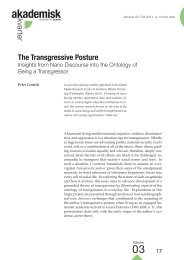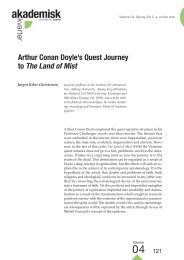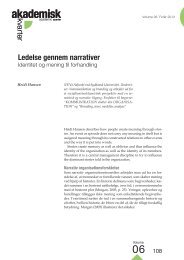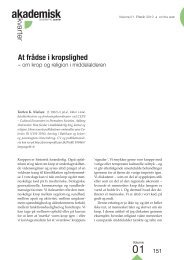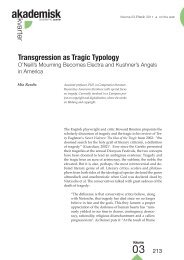Academic Quarter - Akademisk kvarter
Academic Quarter - Akademisk kvarter
Academic Quarter - Akademisk kvarter
Create successful ePaper yourself
Turn your PDF publications into a flip-book with our unique Google optimized e-Paper software.
akademiskacademic quarter<strong>kvarter</strong>Meet your insideJan Eric Olsénance in short stages the swallowing of a pillcamera, the transmission of the images to acomputer and the projection of the endoscopicimages on a large screen along with old SFmoviessuch as Fantastic Voyage and The Manwith the X-ray Eyes (1963). In Copenhagen, theperformance also featured a screening of JamesWilliamsons hilarious trick-film The Big Swallow(1901), which shows how the cameraman,shooting from the same angle as the audience,is engulfed by the sole character in the film.The London performance on the other hand,included a demonstration of marine bioluminescence.By presenting innovative technologyalongside old-fashioned movies and luminousmarine organisms, Warnell draws our attentionto the cultural construction of transparency.Compared to bioluminescent organismswhose green phosphoric radiation illuminatesthe deep sea, endoscopic transparency isachieved through a series of mediated imagesthat derive from compact and solid technologysuch as the pill camera and the software thatmakes the gastrointestinal images visible onthe computer screen. Only in converted form,disengaged from the inside it points back to,does the pill camera show us our transparentflesh.Obviously, the different technological devicesused to visualize the inner body, is not theonly thing that differs Bordowitz’ descriptionfrom Warnell’s performance. Set in a hospitalcontext with illness as an unyielding factor,Bordowitz experience of endoscopic examinationis as private as Warnell’s gastrointestinalvoyage is public. It’s doubtful whether Warnellhad been able to perform Endo/Ecto had it notbeen for the wireless and automatic applicationof capsule endoscopy. With José van Dijckwe could say that the pill camera takes the notionof a permeable body that can be viewedsmoothly from within, even further than fibreoptic video endoscopy (van Dijck, 2005: 66). Inthis respect, the endoscopic gaze that van Dijcktraces through the shifting media landscape ofthe twentieth-century has converged with thescanning technologies of today. Both seem to offeran image of the body as a porous entity thatwe no longer have to cut open in order to see.As van Dijck rightly points out, medical visualizationsand media technologies have alwaysbeen inextricably interweaved with one another,which is to say that the public spectacle is aningrained element of the medical gaze. Today’subiquitous information networks have hardlymade medical visualizations less spectacular.We have only to consider the spread of the VisibleHuman Project on the Internet, to recognizethe persistence of this scopic quality in medicine.Whether increased visibility necessarilyleads to a familiarization of the inner body, asvan Dijck argues, is however disputable (vanDijck, 2005: 69). It may be that the proliferationof medical visualizations in information societyhas yielded an understanding of the bodyas perfectly transparent and accessible. Yet,since this transparency and porosity is intrinsicallytechnological, the perception of the innerbody is caught up in the ever-changing frameof the visual apparatus; lenses, scopes, fibreoptics, video monitors, TV screens, computerwindows etc.According to Tom Gunning, technologicalinnovations incite feelings of astonishment andwonder that tend to fade away shortly after thenew technology becomes routine. Gunningalso notes that this feeling of astonishment isnot merely caused by a sense of unfamiliarityVolume01 27


